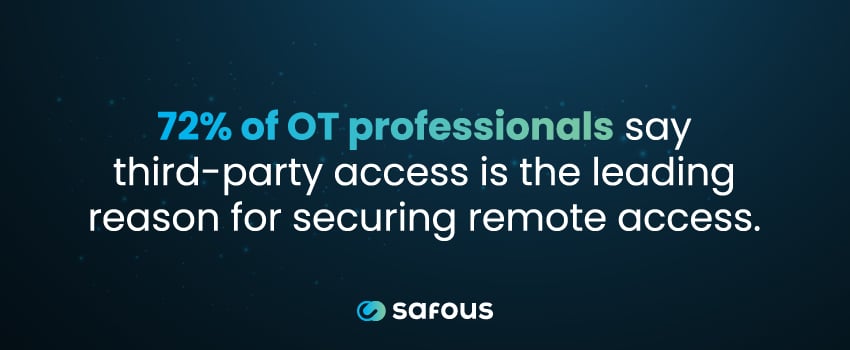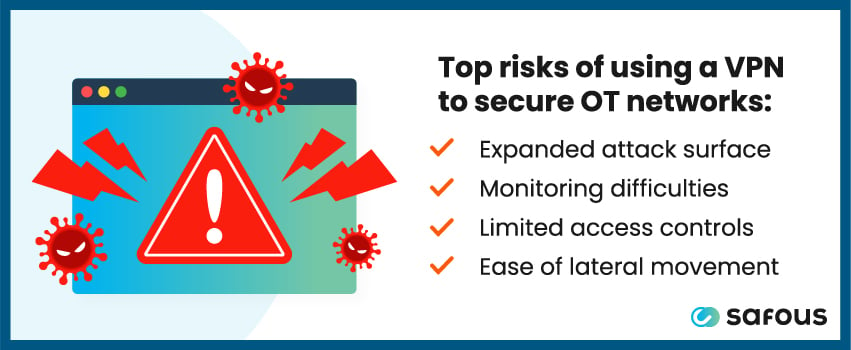Secure remote access to operational technology (OT) environments has become an essential requirement across industrial sectors. As more organizations integrate IT and OT systems, the traditional approach of keeping OT infrastructure completely isolated is no longer viable.
Over half (54%) of industrial companies suffered a ransomware attack that impacted their OT in 2023.1 Clearly, the increasing convergence of IT and OT, coupled with the growing reliance on third-party vendors and remote work models, has created a pressing need for modern security tools designed to strengthen remote access to OT networks.
Enter industrial secure remote access (I-SRA), a crucial component of OT security strategies. I-SRA refers to the processes and technologies used to enable secure remote access to OT environments, allowing authorized personnel – including vendors, contractors, and remote workers – to access and manage industrial systems while mitigating the risk of data breaches.
Read on to learn more about the importance of I-SRA and why more businesses are turning to zero trust to safeguard their OT environments.
What Is the Current State of I-SRA?
A 2023 survey found that 72% of OT professionals ranked third-party access as the leading reason for securing remote access.2 But while the need for I-SRA is widely recognized, many industrial leaders aren’t confident that current remote access solutions can secure their critical OT environments effectively.
Industrial organizations have attempted to address I-SRA through makeshift workarounds, such as virtual private networks (VPNs), firewalls, or frameworks like NIST 800-82 or ISA/IEC62443. However, these solutions often fail to provide comprehensive security or cater to the unique requirements of OT systems – underscoring the growing urgency for purpose-built I-SRA solutions.

What Is the VPN Approach to OT Security?
VPNs have long been a popular choice for enterprise IT connectivity due to their ability to encrypt network traffic and conceal the user's location, offering some privacy and security capabilities. However, VPNs were not designed specifically for OT environments, and their inability to accommodate the unique configurations and protocols found in OT systems creates several challenges. As a result, implementing VPNs for OT remote access often requires coordination between IT and OT teams to address the discrepancies between VPN capabilities and OT requirements.
What Are the Security Risks of Using a VPN?
While VPNs enable basic remote connectivity for OT, they were never meant to be a comprehensive solution – especially given the dangerous ramifications of an OT security breach. Some risks of using a VPN to secure OT networks include:
Expanded Attack Surface
VPNs establish connections over the public internet, effectively creating an entry point for malicious actors to potentially gain access to the network. If user credentials are compromised through techniques like phishing or brute-force attacks, attackers can exploit this pathway to infiltrate the entire OT network directly.
Monitoring Difficulties
VPN logs and audit trails provide limited visibility into user activities, making it difficult to determine which systems were accessed or what actions were taken during a session. This lack of detailed monitoring and auditing capabilities creates significant gaps in an organization's ability to investigate potential threats, conduct forensic analysis, and ensure compliance in OT environments.
Limited Access Controls
A major limitation of VPNs is their inability to implement granular access controls. VPNs operate on a binary allow/deny basis for network access without the capability to restrict specific user actions or enforce least-privilege principles once a user is connected, resulting in an excessive level of privilege.
Ease of Lateral Movement
OT networks typically can’t be segmented using traditional methods due to the unique protocols and architectures employed. This lack of internal network segmentation means that if a threat actor manages to infiltrate a single system within the OT environment through a VPN connection, they may be able to move laterally and gain access to all connected OT assets without encountering additional security barriers.

How Zero Trust Enhances OT Security
The zero-trust security model challenges the traditional perimeter-based approach to OT security. Based on the principle of "never trust, always verify," zero trust enhances OT network protection by integrating tools like multi-factor authentication, network segmentation, continuous monitoring, and identity-based access.
Some benefits of leveraging zero trust security within your I-SRA strategy include:
Improved Visibility and Control
Zero-trust security solutions improve visibility and control over organizations' OT environments, enabling them to detect and respond more effectively to threats while minimizing lateral network movement through stronger access controls and network segmentation.
Dynamic Security
Zero-trust tools continuously verify users and devices, enforce stringent access controls, and implement robust security measures. This proactive approach to security is well-suited for the dynamic nature of OT environments and the evolving threat landscape.
Simple Customization
Unlike traditional security solutions designed for IT use cases, zero-trust platforms can be tailored to meet the specific needs of OT systems, ensuring seamless integration and protection without disrupting critical operations.
Extend Zero Trust Access to Your I-SRA Environment With Safous
Securing remote access to OT environments is critical for maintaining the safety of industrial operations. To safeguard these sensitive systems effectively, businesses must adopt a comprehensive security approach that goes beyond traditional perimeter-based solutions and embraces the principles of zero trust access.
The Safous Zero Trust Access (ZTA) platform can help you extend zero trust security to your industrial SRA strategy. Safous ZTA provides organizations with a suite of security tools to safeguard the entire OT environment, so your teams can monitor and manage remote access to critical applications and data seamlessly. Request a demo today to get started.
Sources:
Receive the latest news, events, webcasts and special offers!
Share this
You May Also Like
These Related Stories

Why Human-Approved Access Matters for AI-Automated Operations

SRA vs. RPAM: Which Is Right for Your Business?


